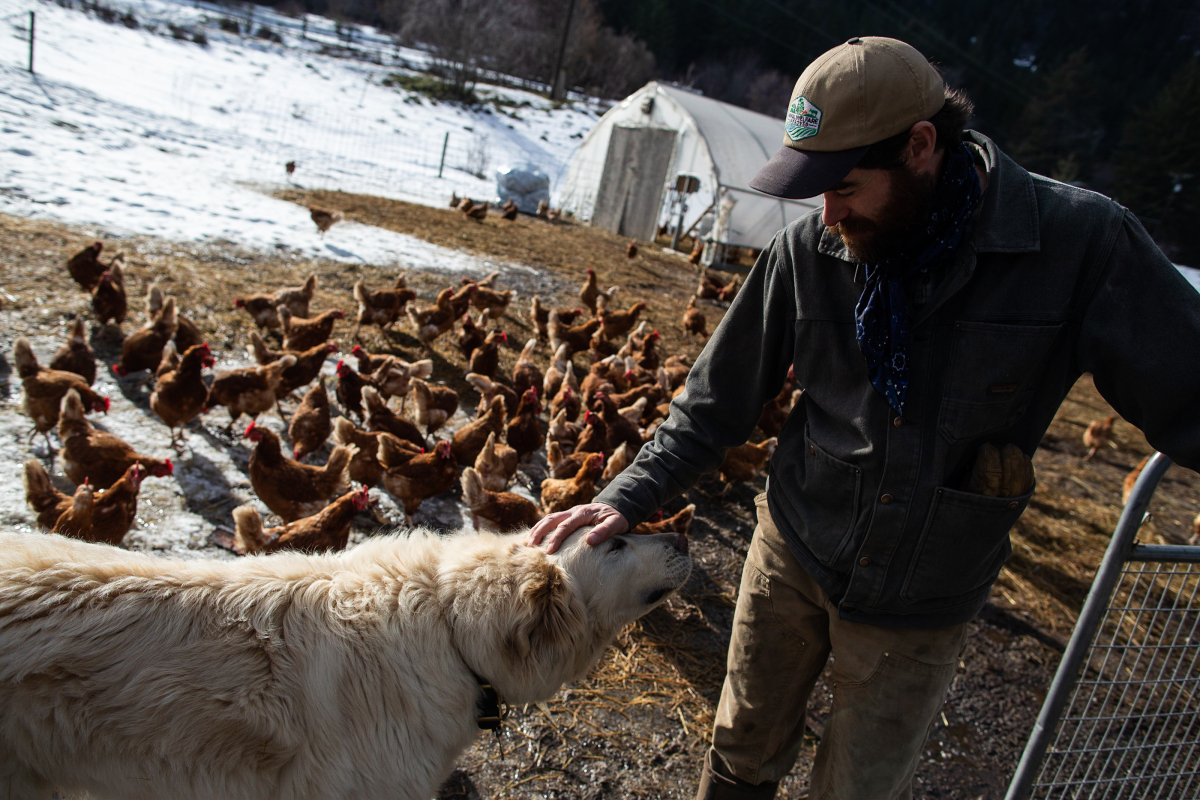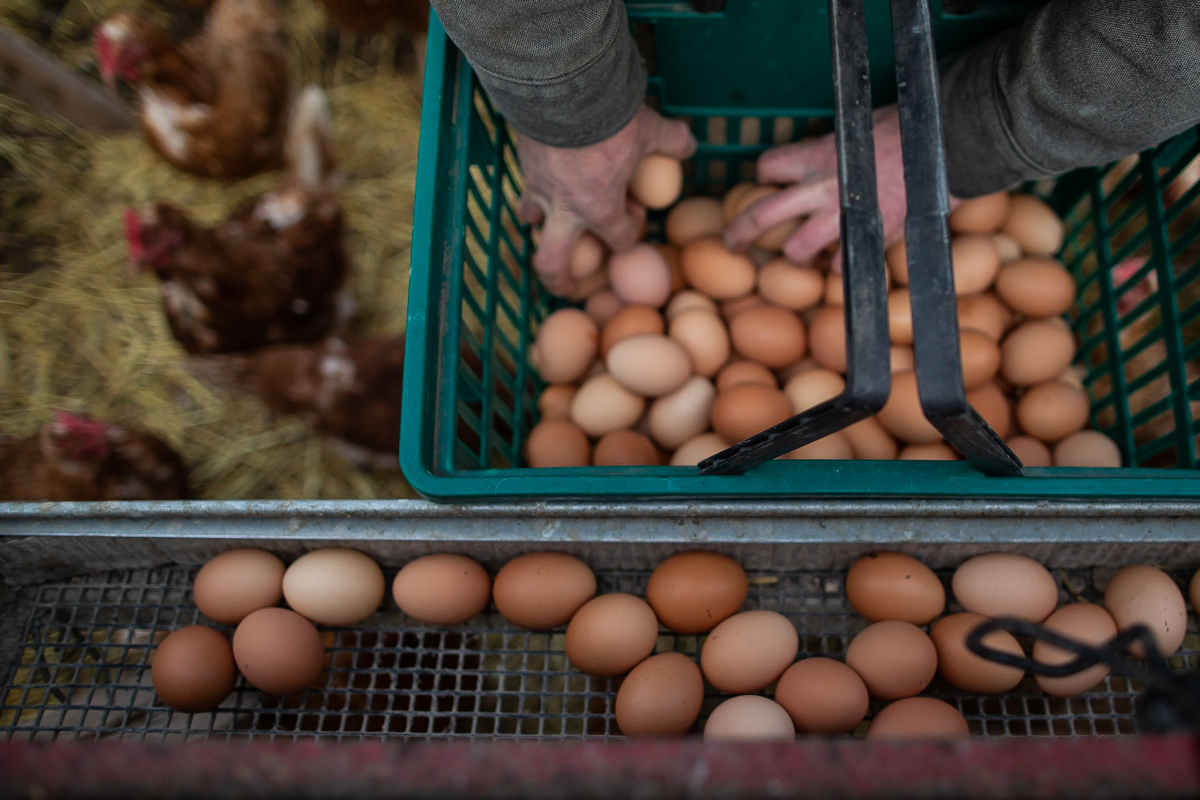Support strong Canadian climate journalism for 2025
Sunlight glowed through Tristan Banwell's thick brown beard as he trudged through half-melted snowdrifts towards a herd of small brown cows chowing down on a hay bale one mid-February morning near Lillooet, B.C. Thick fog that had cloaked the Fraser Canyon earlier that morning lifted, revealing snow-capped mountains towering on the horizon.
Banwell was smiling. After weeks on the road delivering soup bones and steaks across southern B.C. and picking up a new bull stateside, he was delighted to be back on the farm.
"I love being around animals, I love spending time caring for them and seeing them through the different phases of their lives," explained Banwell. "I just love to create food that I pass on to people and find that it's really meaningful — a vocation — to produce something people value."

Despite looking the part in Carhartt pants and mud-splattered boots, Banwell and his wife Aubyn are unusual ranchers. Originally from California, they were vegan for years out of concern for the environment and animal welfare. It was only about a decade ago, after leaving the city, that they started to fall in love with meat.
Globally, food has a major environmental footprint, polluting waterways and generating about a third of the world's greenhouse gas emissions. Meat, especially beef, has a disproportionately large impact: Raising animals requires land for pasture and to grow feed, and cows' digestive systems emit lots of methane, a potent greenhouse gas.
Yet in wealthy countries like Canada, there is a massive demand for cheap chicken, bargain beef and low-priced pork. Statistics Canada reports Canadians eat two times more meat than the global average, exacerbating the problem of carbon emissions produced by our food. To meet this voracious demand, the handful of meat producers who control the bulk of Canada's meat industry depend on industrial farms and meat processing plants, despite the industry's questionable track record when it comes to protecting the environment and workers' rights.

In the face of these problems, everyone from farmers to governments to big food companies are eyeing so-called "regenerative farming," a suite of practices that use plants and livestock to improve soil health. Soil is typically home to billions of microbes that transform dead organisms and animal dung into nutrients, sequestering carbon into the ground.
But on conventional industrial farms, artificial fertilizers and pesticides circumvent this natural process, allowing farmers to grow crops without manure. Meanwhile, industrially produced meat is grown in feedlots on diets of conventionally grown soy and corn. Regenerative farming rejects many of these practices in favour of carefully raising crops and livestock together and other methods that promote soil health.
Banwell, like other regenerative ranchers, uses animals judiciously to support pastures and grasslands, ecosystems renowned for their ability to sequester carbon and promote biodiversity. Cows, pigs and chickens aerate and fertilize the soil — a close relationship between animals, plants and people unimaginable on an industrial farm.
"Factory farming (has) broken the contract that we have with livestock," Banwell said as the cows munched on a bale of hay. "Understanding their needs and being connected to them is part of regenerative farming to me."

The Banwells didn't plan on becoming ranchers. Tristan moved north from California after high school to study conservation biology in Vancouver, while Aubyn completed a fine arts degree in Tacoma, Wash. Neither of them ate meat at the time, he said, citing concerns around the "exploitative" nature of industrial animal agriculture.
Then, after years in the city, they moved to a homestead in Washington state — and their perspective started to change.
"We started raising chickens and ducks for eggs, and started to see that we could raise meat in a way that wasn't exploitative," Banwell said. Soon, they were omnivores who, to their own surprise, "really liked" meat and farming.
At the time, the couple used regenerative practices because they "made sense" for their farm. They had read up on sustainable farming practices like organic farming, permaculture and agroecology, borrowing concepts from each and adapting them to their needs. Regenerative farming, which only became a buzzword about 10 years ago, borrows practices from these more established traditions.

Five years into their homesteading endeavour, the Banwells were ready to leave the U.S., and their sights were set on B.C. Serendipity connected them with a Seattle-area couple who wanted to buy Spray Creek Ranch, a 260-acre ranch near Lillooet that came with grazing rights to nearby mountain tenures in key grizzly bear habitat. The buyers were looking for people to farm the property, regenerate the land and prioritize bears over beef in their farming practices. The couple jumped at the opportunity to start a new life in the Fraser Canyon.
When they arrived, the ranch was a cow-calf operation, a business model where ranchers breed heifers and raise the calves for the first several months of their lives before selling them to large feedlots, typically in Alberta. There, the calves are fattened on grain-based feed and then slaughtered in huge meat-packing plants. Most Canadian beef is grown this way, even if it is unprofitable for all but the largest ranches. Prices farmers receive for their calves haven't kept pace with increases to the costs of production over the past decades, pushing many small- and medium-sized ranchers out of the industry entirely.
As soon as they arrived, the Banwells started transforming the business. They implemented a suite of regenerative practices, including moving the cows daily to prevent overgrazing and ensuring the manure is evenly distributed. Their heritage-breed pigs were set loose in fields to eat excess heritage fruit and break up the soil, while they moved chickens around the property in so-called chicken tractors — open-air pens that can be easily moved around a field — to fertilize the ground and break up cow patties.

They got organic, regenerative and humane animal treatment certifications to guarantee customers of their practices. The paperwork helps them fetch a premium price: A sirloin steak from Banwell's ranch goes for $17 a pound, about $5 above the Canadian average, according to Statistics Canada. A dozen eggs sell for $8, over twice the national average.
The ranch also started selling directly to local customers instead of big food companies; an effort, Banwell explained, to "rebuild the relationship between the producers of our food and the customers who depend on it."
Finding people willing to pay a premium price for better meat was easy. Budget foodies looking to ensure they spent their meat dollars on quality cuts, vegetarian parents feeding their kids ethical meat and even ex-vegans looking to eat meat again all snatched up his products. More recently, Banwell has had customers who reached out after learning about regenerative ranching from Netflix documentaries, magazine articles or on social media.

While this buzz could signal a positive shift as more people seek out sustainable food, critics doubt that regenerative ranching will help solve the climate crisis.
"When you're talking about regenerative agriculture, it's really important to define the term itself and then define a set of constituent practices," said Harvard Law School fellow Jan Dutkiewicz, a political economist who studies meat and climate change. "There's no single thing called regenerative agriculture."
The problem, he explained, is that the positive climate and environmental impacts of specific regenerative practices like cover cropping or rotational grazing vary wildly depending on the soil, landscape, rainfall and size of any given field or pasture. That variability is often glossed over by popular advocates for the approach, who he said rely on anecdotes and a smattering of data points to support their claims — a "bullshit" approach if the claims can't be peer-reviewed, Dutkiewicz said.
The problem is highlighted by the strict rules for organic farming, a government-regulated system that ensures organically-certified farmers are actually using methods that protect soil health.
While organic agriculture's well-known ban on artificial pesticides and fertilizers is commonly seen as a health-motivated decision, in fact it exists primarily to protect soil ecosystems, said Dag Falck, a leader in Canada's organic movement. The organic rules are designed to protect soil while helping consumers trust that farmers are actually using sustainable practices. Without the accountability of regulated standards, Falck, Banwell and other sustainable farmers are concerned the term "regenerative farming" could eventually become so common that it would be meaningless.

"I don't want to cast it strictly as greenwashing (because) I think you can use regenerative farm practices and not be certified organic," said Banwell, who is involved in B.C.'s organic certification and trade association. "But as the term has developed momentum, really big operations have jumped on it because they can just say their farm is regenerative without actually having to prove it."
For instance, last year Cargill, one of the world's largest meat producers, alongside fast food chains like A&W and McDonald’s, launched a “Beef Up” sustainability initiative to "cut beef emissions by 30 per cent in North America," according to the coalition's website. News releases about the plan emphasize that regenerative farming practices like cover cropping and promoting pasture health will be key parts of these efforts — but the farmers supplying Cargill will not be required to seek organic certification or measure how much carbon they sequester.

Dutkiewicz, the Harvard professor, cautioned that these kinds of regenerative farming initiatives can distract from the most effective way for rich countries like Canada to reduce their emissions: Persuading people to eat less meat, especially meat raised on industrial farms.
Dozens of studies show that reducing meat consumption in wealthy countries like Canada, the U.S. and EU nations is essential to curb the climate crisis. Eating fewer animals also has other benefits like reducing antibiotic resistance, zoonotic diseases and some chronic health problems.
Yet meat consumption in rich countries remains high, despite splashy headlines about plant-based and lab-grown meat replacing the real stuff. Moreover, Statistics Canada data show large Canadian supermarkets like Loblaws or Sobeys, which rely primarily on industrial farms for their supply, are responsible for selling nearly three-quarters of Canada's meat, followed by restaurants and convenience stores.

Banwell and other small farmers who sell directly to consumers make up less than three per cent of all Canadian meat sales.
This difference in scale is "the elephant in the room," said Dutkiewicz — a rare point of commonality among rival experts who typically fight bitterly about their duelling views on the future of meat. He believes people in rich countries will never agree to eat less meat. Instead, governments should boost the consumption of plant-based and lab-grown meats better adapted to the existing industrial food system, Dutkiewicz said, adding he can see a day when animal agriculture is eliminated entirely.
Others, including Banwell, say governments should enact policies that incentivize people to eat less and opt for high-quality meat raised in a way that supports the environment and farming communities. This position is backed by global expert groups like the EAT-Lancet Commission and the UN's Food and Agriculture Organization.

Walking back towards the house he shares with Aubyn and their children, Banwell paused briefly to take in the late-winter sunlight. After a summer hemmed in by forest fires that filled the air with thick, acrid smoke for weeks on end, the clean winter air was a relief. Here, in a valley far away from the harsh debates on the future of meat and livestock farming, Banwell is trying to live responsibly at the front lines of climate change — a practice that, for him, means raising livestock and eating meat in an effort to regenerate the soil and the connection between people and their food.
"The reality of the world is really messy and complicated and all sorts of grey," he said. "There's many infinite ways to produce food, and from a consumer perspective, there's good, better and best (options). Just make the best choice with the resources you have available at that time and don't beat yourself up about the rest."






Comments
Thanks for this. I agree that animals can be an important part of the farm, the farm ecology. I'm lucky to live in an area where I can buy locally grown, grass fed beef. The Cariboo region of BC is too cold to grow many grain crops, but it is well suited for cattle ranching. If ranchers and farmers look after the soil and not overgraze the land, raising cows can be sustainable.
Studies have shown that grass-fed cattle produce higher greenhouse-gas emissions than grain-fed cattle. This is because commercial feeds are less fibrous, resulting in less methane production, and because grain-fed animals reach slaughter weight sooner, thus reducing lifetime emissions.
In addition, according to at least one study, “Good grazing management cannot offset its own emissions, let alone those arising from other systems of animal production. What’s more, soils being farmed using a new system of management, such as grazing, reach carbon equilibrium, where the carbon that flows into soils equal carbon flows out, within a few decades. This means that any benefits from grass-fed cows are time-limited, while the problems of methane and other gases continue for as long as the livestock remain on the land.”
“Why eating grass-fed beef isn’t going to help fight climate change” (The Conversation)
https://theconversation.com/why-eating-grass-fed-beef-isnt-going-to-hel…
Finally, let’s not kid ourselves about some mythical, mutually agreed “contract” with farmed animals that includes killing them long before the end of their natural lifespans. We humans are a truly exceptional species when it comes to rationalizing the harms we inflict on others.
There is a huge contingent of the population that agrees that climate change is a huge crisis for the planet. If all these people would switch from eating meat to eating insects, we could significantly reduce the threat of climate change. Why aren't they? Just complaining about climate change is not good enough. They must show the way forward to all the meat eating climate deniers. Please lead, and the deniers will follow.
Regenerative Agriculture and holistic planned/managed grazing (which is far different than just cattle grazing on pasture) is THE most hopeful way to an ecologically secure future. The Audubon Society partners with Regenerative ranchers for a reason, because the BIRDS come back, the INSECTS and BUTTERFLIES thrive. We actually need far MORE cattle on land and the ONLY way to heal land that has desertified is with managed grazing.
If anyone says that regen ag contributes to global warming, they are NOT looking at true managed grazing and regenerative agriculture. Animals on land (that mimic herds) are PART of the carbon cycle. It's not the animals that have been the problem, it's the management.
The issue is admittedly complex. But various studies indicate that in general the best way to promote biodiversity and to absorb carbon is to rewild agricultural land. This is possible to do on a large scale because animal agriculture is so very inefficient in terms of food-bang for the land-buck.
https://allianceforscience.cornell.edu/blog/2020/10/rewilding-farmland-…
https://www.theguardian.com/commentisfree/2017/oct/04/livestock-farming…
No, meat in moderation cannot be part of the climate solution. For a scientific analysis, see https://www.theguardian.com/environment/2020/dec/23/organic-meat-produc….
No, meat in moderation cannot be part of the climate solution. For a scientific analysis, see https://www.theguardian.com/environment/2020/dec/23/organic-meat-produc….
Everyone that eats meat is a climate change denier.
George Monbiot, "How to feed the world without destroying it":
https://www.theguardian.com/environment/audio/2022/jun/03/how-to-feed-t…